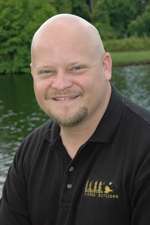
When you're a big-time bass pro like Bassmaster Elite angler Terry Scroggins, competition is in your blood. There's probably no way to determine the number of bass tournaments he's fished in his life, but to say it approaches four figures would not be an exaggeration. Some of those tournaments include Bassmaster Classics, where careers are made. Others are like the Bassmaster Elite Series, where Big Show makes a living and pays his bills. Still others are like the single-day events that most Bassmasters fish all around the country and world.
Just last week, the Team Toyota pro found himself competing in a celebrity pro-am bass tournament on Texas' Lake Lewisville, benefiting a charity sponsored by NASCAR driver Kyle Busch. It was a one-day event, and he had less than a day to practice — a situation that a lot of anglers find themselves in all too often.
Scroggins had only fished Lewisville once before, so he had to make the most of those few hours of practice. Fortunately, he had a plan.
"The first thing you have to look at is the time of year," Big Show says. "When I fished Lewisville before [in a 2005 Elite 50 tournament], it was summertime, so the places I caught bass then aren't likely to be productive now.
"I'll start by checking out a standard fall pattern, looking for bass in the backs of creeks with lots of shad. As I recall, Lewisville only has a few creeks like that, so it'll be a pattern I can check very quickly."
Armed with square-billed crankbaits and spinnerbaits, the Toyota pro staffer will motor all the way to the back of a creek at this time of year and work his way out toward the main lake.
"I'm pretty sure I'm going to intercept bass somewhere in there," Scroggins says, "and a great thing about this particular pattern is that I might be able to establish it without ever making a cast."
If Scroggins sees balls of shad in the backs of creeks and the occasional marauding bass taking a swipe at them, he might just turn his boat around and look to the next creek. Signs like that give him confidence that he can come back on the first competition day and catch some fish.
"With this particular fall pattern, the bass are either there or they're not," he says. "If I can see the shad, I know bass will be close by. I should be able to scout this pattern in my first hour or so. There's no point in sticking a few and wasting those opportunities in practice."
But if the bass aren't on this pattern, Scroggins has a backup plan. The affable Floridian takes stock of the other cover and structure options on the lake and begins to eliminate them.
"On Lewisville, that means contour breaks, humps in front of the creeks and maybe some standing timber. Finding the productive pattern means eliminating those alternatives as quickly as possible. That's especially important when your practice time is so limited."
In the end, Scroggins didn't win at Lewisville, but he placed high, had a great time and supported a good cause. If the tournament had been a club or circuit event, he'd have racked up some points and left himself in good position for the rest of the season.





